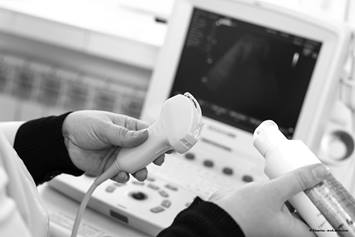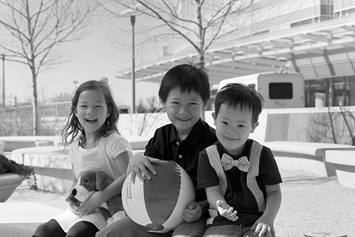Arthrogryposis
This is a rare disorder occurring in 1 out of every 3,000 live births. The incidence of true amyoplasia occurs in 1 out of every 10,000 live births.
What Is Arthrogryposis?
Arthrogryposis, also called arthrogryposis multiplex congenita (AMC), involves a variety of non-progressive conditions that are characterized by multiple joint contractures (stiffness) and involves muscle weakness found throughout the body at birth. This disorder should be considered a symptom complex or a descriptive term rather than a disease and an underlying cause should be sought when possible. The most common type of arthrogryposis is called amyoplasia in which the hands, wrists, elbows, shoulders, hips, feet and knees are affected. In more severe types, every joint can be affected including the jaw and spine. The name, derived from the Greek, means “curved or hooked joints”.
Incidence/Prevalence:
- This is a rare disorder occurring in 1 out of every 3,000 live births; and the incidence of true amyoplasia occurs in 1 out of every 10,000 live births.
- It is reported that amyoplasia comprises 43% of reported cases.
- No racial tendency is present.
- Males are more affected in X-linked recessive disorders; otherwise, females and males are equally affected.
- Arthrogryposis is detected at birth or in utero using ultrasound.
- As many as 150 syndromes have similar features with arthrogryposis.
- The majority of individuals thrive with an average or above average intellect.
- The life span of affected people depends on the severity of the syndrome and associated malformations, but is often normal.
Prognosis
The main point to remember is that AMC is not a progressive disorder. Typically these children have normal speech and learning capabilities and with proper care, vigorous therapy and in some cases, surgical interventions, the potential for them to lead productive, rewarding, independent lives is excellent.
Success stories of patients with AMC
- Marty Sheedy-An activist and motivational speaker with AMC.
- Lee Pearson-British 11-time gold medal winner at the Paralympic games in dressage.
- Mike Begum-A competitive fighting game player.
- Sunny Taylor-An American painter and activist.
- Nicholas Taylor-An American 3-time Paralympic champion in Quad Tennis.
- Luca “LazyLegz” Patuelli-A Canadian B-boy dancer on numerous television shows.
- Prudence Mabhena-Lead singer for the band “Liyana”.
What Causes Arthrogryposis?
While there is no single cause for arthrogryposis, one known factor is “fetal akinesia”, which is decreased fetal movement in utero. During the early growth phase, joint development is almost always normal. Motion/movement is essential for joint development and tissue structures. When there is a lack of fetal movement, this can cause extra connective tissue to develop causing a stiff, immobile joint. The longer the immobility, the worse the contracture.
- Extrinsic (outside factors): Insufficient room in the uterus; low amniotic fluid or abnormally shaped uterus; maternal infection, drugs, trauma as well as other causes.
- Intrinsic (within the child): Neurological (malformed spinal cord or areas within the brain; Connective tissue disorders (tendons, ligaments, bones or joint lining).
Genetics
Most individuals do not have an associated genetic reason for arthrogryposis. In about 30% of cases, a genetic cause can be found. This does not usually occur more than once in a family, but the risk of recurrence varies with the type of genetic disorder. Almost all cases of the most common amyoplasia type are sporadic without a genetic link. An autosomal dominant transmission has been noted, most notably in type I distal arthrogryposis. There is a rare X-linked recessive type as well as autosomal recessive inherited variety. There are rare cases of mitochondrial inheritance reported as well.
How Is Arthrogryposis Diagnosed?
There is no prenatal diagnostic tool to test for this condition. During a routine ultrasound, abnormal limbs may be noted, but no definitive cause can be ascertained until further tests can be run.
- Blood work is typical, especially genetic testing. The department of genetics will also see the child and explain the work-up.
- Muscle biopsies are frequently done to determine a cause or rule out other conditions.
- At times, an electromyography (EMG), will be performed to make a distinction between myopathic and neurogenic arthrogryposis.
- A full history and general exam of the clinical findings are the mainstay of diagnosis.
How Is Arthrogryposis Treated?
There is no absolute cure for this condition; however, quality of life can be greatly improved depending on the severity of the syndrome and each individual patient’s needs. It’s important that the care-givers be very involved and the treatment stem from a multi-disciplinary approach:
- Physical and occupational therapy which may include stretching, casting, strengthening, mobility training and addressing fine motor skills to improve range of motion and foster independence.
- Pyschosocial and emotional issues need to be addressed early on to build a child’s self-esteem and teach them how to lead a full, productive life.
- There are a variety of orthopedic surgery options that may be needed for a child with arthrogryposis. Some are simple, such as an Achilles tendon release, some are moderate, including elbow and knee surgeries and some are very involved, including limb lengthening and spinal surgery. Each patient will have an individualized orthopedic exam (which may include X-rays), and any surgical options will be discussed with care-givers so that a well-informed decision can be made regarding any proposed surgery.
When to Call for an Appointment
All of the pediatric orthopedic surgeons at Nationwide Children’s Hospital are trained and comfortable treating children with arthrogryposis. They are usually referred to one of our orthopedic centers within 2-4 weeks of birth to perform a full history and physical exam and to determine if any early testing or treatments need initiated. They will need to see the genetics team, therapy teams and other specialties depending on their individual issues. Contact our Orthopedics department at (614) 722-5175.
Clinical Findings
The classic findings of the amyoplasia variety of arthrogryposis present with well-recognized musculoskeletal abnormalities:
- Bright-eyed intelligent children; normal to above average cognition.
- Many have a mid-line forehead cutaneous hemangioma.
- Frequent posture includes: Internal shoulder rotation; elbow extension (sometimes flexed) and forearm pronation; wrist flexion and ulnar deviation; fingers in fixed flexion and thumb-in-palm deformity; hip flexed, abducted, externally rotated, and often dislocated; knee flexion or extension; and foot deformities (clubfoot and/or vertical talus).
- The arms and legs are often thin and atrophic and the joints lack flexion creases.
- Typically all four extremities are involved, but there are some with just upper or lower involvement.
- Sensation is usually normal.
- Babies are often in breech position, most likely due to an inability to kick and rotate into proper position. Many times if the diagnosis has been made prenatally, these children are delivered by cesarean section.
- Distal arthrogryposis syndromes involve the more peripheral joints (i.e.-Type I) and can have more extensive hand and feet involvement.
- Other, more uncommon problems include scoliosis, respiratory issues, facial and jaw variations and abdominal hernias.



